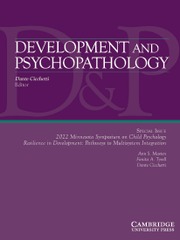Crossref Citations
This article has been cited by the following publications. This list is generated based on data provided by
Crossref.
Done, D. J.
2002.
Risk and Protective Factors in Schizophrenia.
p.
185.
Cicchetti, Dante
and
Rogosch, Fred A.
2002.
A developmental psychopathology perspective on adolescence..
Journal of Consulting and Clinical Psychology,
Vol. 70,
Issue. 1,
p.
6.
Wakschlag, Lauren S
Pickett, Kate E
Middlecamp, Molly K
Walton, Laura L
Tenzer, Penny
and
Leventhal, Bennett L
2003.
Pregnant smokers who quit, pregnant smokers who don’t: does history of problem behavior make a difference?.
Social Science & Medicine,
Vol. 56,
Issue. 12,
p.
2449.
Dixon, Angela
2003.
‘At All Costs Let Us Avoid Any Risk of Allowing Our Hearts to be Broken Again’: A Review of John Bowlby’s Forty-Four Juvenile Thieves.
Clinical Child Psychology and Psychiatry,
Vol. 8,
Issue. 2,
p.
278.
Done, D. John
2004.
Search for the Causes of Schizophrenia.
p.
91.
Shaffer, Howard J
LaBrie, Richard A
LaPlante, Debi A
Nelson, Sarah E
and
Stanton, Michael V
2004.
The Road Less Travelled: Moving from Distribution to Determinants in the Study of Gambling Epidemiology.
The Canadian Journal of Psychiatry,
Vol. 49,
Issue. 8,
p.
504.
Holmbeck, Grayson N.
Greenley, Rachel Neff
and
Franks, Elizabeth A.
2004.
Handbook of Interventions that Work with Children and Adolescents.
p.
27.
Reitz, E.
Deković, M.
and
Meijer, A. M.
2005.
The Structure and Stability of Externalizing and Internalizing Problem Behavior During Early Adolescence.
Journal of Youth and Adolescence,
Vol. 34,
Issue. 6,
p.
577.
Ford, Sabrina
Farah, Martha S.
Shera, David M.
and
Hurt, Hallam
2007.
Neurocognitive Correlates of Problem Behavior in Environmentally At-Risk Adolescents.
Journal of Developmental & Behavioral Pediatrics,
Vol. 28,
Issue. 5,
p.
376.
MOLDE, HELGE
PALLESEN, STÅLE
BARTONE, PAUL
HYSTAD, SIGURD
and
JOHNSEN, BJØRN HELGE
2009.
Prevalence and correlates of gambling among 16 to 19‐year‐old adolescents in Norway.
Scandinavian Journal of Psychology,
Vol. 50,
Issue. 1,
p.
55.
Trinidad, Alma M.O.
2009.
Toward kuleana (responsibility): A case study of a contextually grounded intervention for Native Hawaiian youth and young adults.
Aggression and Violent Behavior,
Vol. 14,
Issue. 6,
p.
488.
Moore, Mary Julia C.
and
Buehler, Cheryl
2011.
Parents’ divorce proneness: The influence of adolescent problem behaviors and parental efficacy.
Journal of Social and Personal Relationships,
Vol. 28,
Issue. 5,
p.
634.
Padilla‐Walker, Laura M.
Fraser, Ashley M.
and
Harper, James M.
2012.
Walking the walk: The moderating role of proactive parenting on adolescents' value‐congruent behaviors.
Journal of Adolescence,
Vol. 35,
Issue. 5,
p.
1141.
Sun, Xiaojun
Tian, Yuan
Zhang, Yongxin
Xie, Xiaochun
Heath, Melissa A.
and
Zhou, Zongkui
2015.
Psychological development and educational problems of left-behind children in rural China.
School Psychology International,
Vol. 36,
Issue. 3,
p.
227.
Burrow, Anthony L.
Hill, Patrick L.
and
Ratner, Kaylin
2016.
Encyclopedia of Adolescence.
p.
1.
Burrow, Anthony L.
Hill, Patrick L.
and
Ratner, Kaylin
2018.
Encyclopedia of Adolescence.
p.
2993.
Eichas, Kyle
Kurtines, William M.
Rinaldi, Roberto L.
and
Farr, A. Celeste
2018.
Promoting Positive Youth Development: A Psychosocial Intervention Evaluation.
Psychosocial Intervention,
Vol. 27,
Issue. 1,
p.
22.
Sharma, Geeti
Gupta, Sahil
Sawhney, Aastha
and
Rastogi, Sanjay
2021.
Examining the influence of demographic marginalisation on performance of the students in higher education.
Journal of Public Affairs,
Vol. 21,
Issue. 3,

